Key Takeaways
- Shower curtains are powerful design elements that can transform your bathroom’s look
- Pattern selection should complement your bathroom size and existing decor
- Material choices impact both aesthetics and functionality
- Color coordination creates visual harmony throughout your bathroom space
- Strategic pattern mixing can elevate your bathroom’s design sophistication
- Custom and DIY options offer unique personalization opportunities
- Proper maintenance extends the life and appearance of your shower curtain
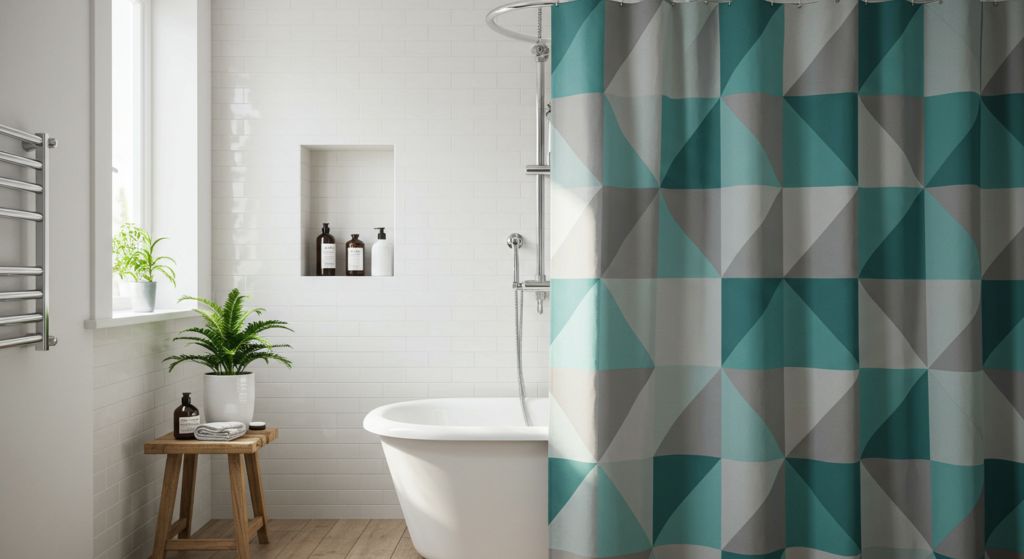
Picture this: You’ve just remodeled your bathroom with gleaming fixtures and perfect tiles, but something still feels… off. Then it hits you—your plain, worn-out shower curtain is dragging down the entire room! As the largest textile piece in most bathrooms, your shower curtain isn’t just functional; it’s a design statement that can make or break your space.
I still remember the dramatic difference when I swapped out the generic white curtain in my guest bathroom for a bold geometric pattern. Visitors started complimenting a space I hadn’t otherwise touched in years! That’s the untapped power of shower curtain styling.
Whether you’re doing a complete bathroom renovation or just need a quick refresh, choosing the right shower curtain pattern, print, and color can transform your bathroom from basic to breathtaking. The best part? It’s one of the most affordable ways to make a significant impact on your bathroom’s overall look and feel.
This guide will walk you through everything you need to know about selecting, coordinating, and styling shower curtains—from pattern selection based on bathroom size to color matching with existing fixtures, and from material considerations to seasonal styling changes.
Let’s dive into the world of shower curtain styling and discover how this often-overlooked element can become the star of your bathroom design.
Understanding Shower Curtain Basics
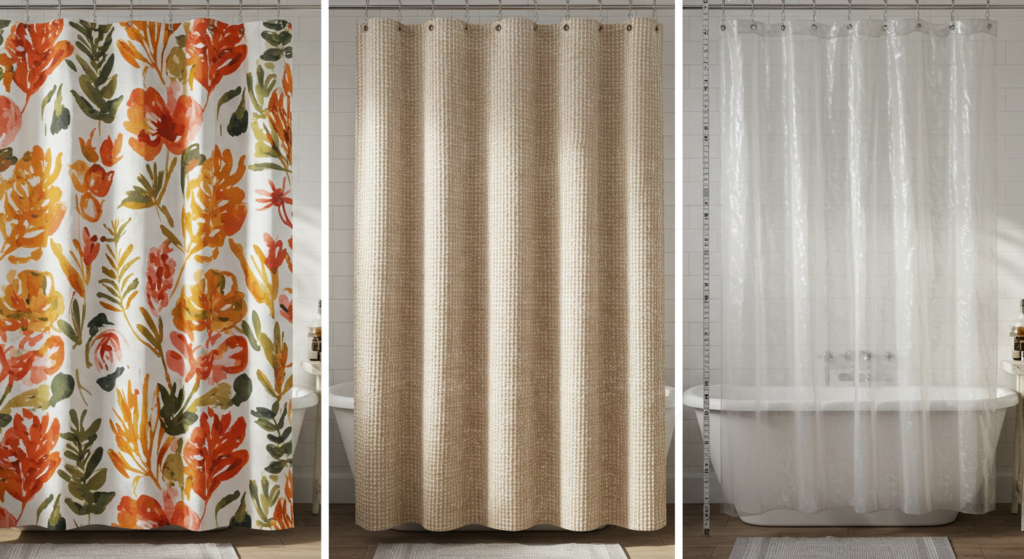
Before diving into patterns and colors, let’s cover some ground rules about shower curtains that will help guide your decisions.
Standard Dimensions and Sizing
Most shower curtains come in standard sizes, typically 72 inches by 72 inches for square showers and 72 inches by 84 inches for taller setups. Measure your space before shopping—nothing ruins a good design faster than a curtain that’s too short or too narrow.
Got a clawfoot tub? You’ll need a specialized 180-inch curtain that wraps around. Custom showers sometimes need custom solutions, and don’t forget to account for how high you hang your curtain rod (ideally 75-82 inches from the floor).
Material Matters
The fabric you choose affects both look and function. Here’s a quick breakdown:
- Polyester: Durable, quick-drying, and available in countless patterns
- Cotton: Soft, natural feel but requires a liner and more maintenance
- PEVA/EVA: Plastic alternatives that resist mildew without PVC chemicals
- Linen blend: Elegant texture that adds sophistication but needs careful care
- Waffle weave: Adds texture and a spa-like quality to minimal bathrooms
Your material choice should balance your style preferences with practical considerations. High-moisture bathrooms with limited ventilation do better with synthetic options that resist mildew.
Curtain vs. Liner Dynamics
Think of your shower setup as having two potential layers: the decorative curtain and the functional liner. While some curtains are designed to work solo, pairing a fabric curtain with a separate waterproof liner often gives you the best of both worlds—style plus functionality.
Liners should be replaced every 6-12 months, while a quality shower curtain can last for years with proper care. This two-part system lets you invest in a curtain you love while cheaply replacing the part that takes the brunt of water exposure.
Assessing Your Bathroom’s Design Potential

Before choosing a shower curtain, take stock of your bathroom’s current design elements and limitations.
Working With Your Space Size
Small bathrooms benefit from certain shower curtain approaches:
- Light colors and subtle patterns create an airy, spacious feel
- Vertical stripes can make your ceiling appear higher
- Semi-transparent curtains prevent the closed-in effect
Larger bathrooms can handle bolder statements:
- Large-scale patterns become focal points
- Dark colors create cozy, defined spaces
- Double curtains or extra-wide options for oversized showers
Medium-sized bathrooms offer balanced flexibility—you can go bold or subtle depending on your preference rather than spatial necessity.
Identifying Your Bathroom Style
Your shower curtain should complement your bathroom’s existing style:
- Modern: Clean lines, geometric patterns, monochromatic schemes
- Traditional: Floral patterns, damask prints, classic color combinations
- Bohemian: Global prints, rich textures, multiple patterns
- Coastal: Blues and whites, nautical stripes, beach motifs
- Minimalist: Solid colors, simple textures, limited pattern
- Farmhouse: Buffalo check, ticking stripes, vintage-inspired prints
Identify which style category your bathroom falls into (or which you aspire to) and use this as a guiding principle for your curtain selection.
Fixture Finish Coordination
Don’t forget to consider your bathroom’s metallic elements:
- Chrome fixtures pair well with cool tones and crisp patterns
- Brushed nickel looks harmonious with earth tones and transitional prints
- Oil-rubbed bronze complements warm colors and traditional patterns
- Brass fixtures shine against jewel tones and bold geometric designs
Your shower curtain doesn’t need to match these elements perfectly, but it should acknowledge them in its color story.
Pattern Selection Strategy

Patterns do more than just look pretty—they serve specific visual functions in your bathroom design.
Scale Considerations
Pattern scale should respond to your bathroom size:
- Small-scale patterns: Tiny florals, pin dots, and fine lines work in smaller spaces without overwhelming them
- Medium-scale patterns: Balanced geometric shapes and mid-sized motifs suit most bathroom dimensions
- Large-scale patterns: Oversized florals and bold graphic elements make statements in larger bathrooms
The general rule: the smaller your bathroom, the smaller the pattern scale should be—though breaking this rule intentionally can sometimes create interesting design tension.
Pattern Types and Their Effects
Different pattern styles create different atmospheric effects:
- Geometric patterns: Create modern, structured energy and can direct the eye (horizontals widen, verticals heighten)
- Organic patterns: Florals, botanicals, and nature-inspired designs bring softness and life
- Abstract patterns: Introduce artistic elements and often combine multiple colors effectively
- Stripes: Versatile classics that can read as traditional, nautical, or modern depending on scale and color
- Novelty prints: Themed designs (like bicycles, animals, or food) add personality and whimsy
- Textural patterns: Subtle textures like linen weaves or tone-on-tone patterns add depth without business
Your pattern choice sets the emotional tone for your bathroom experience—energizing geometrics for morning showers or soothing botanicals for relaxing evening baths.
Placement and Visual Focus
Consider where you want to draw attention:
A standout shower curtain can serve as your bathroom’s focal point, especially if other elements are simple. Conversely, if you have a stunning vanity or tile work, choose a curtain that complements rather than competes.
In bathrooms with spectacular views, a simple curtain keeps the focus on the window. For windowless bathrooms, a vibrant curtain creates a substitute “view” and point of interest.
Color Theory for Bathroom Coordination

Choosing colors strategically can completely transform your bathroom’s mood and apparent size.
Creating Color Harmony
Several approaches can guide your color decisions:
- Monochromatic: Various shades of a single color create sophisticated, cohesive looks
- Complementary: Colors opposite on the color wheel (blue/orange, purple/yellow) create vibrant energy
- Analogous: Colors adjacent on the color wheel (blue/green/teal) offer balanced harmony
- Neutral with accent: A primarily neutral curtain with pops of bright color offers flexibility
- Tonal: Various colors of similar intensity and undertone create subtle sophistication
Most bathrooms benefit from limiting the palette to 2-3 main colors plus accents to avoid visual chaos in a small space.
Working With Existing Elements
Your shower curtain needs to play nice with permanent fixtures:
- Tile coordination: Pick a secondary color from your tile pattern for your curtain to create connection
- Vanity considerations: Wood vanities have undertones (warm/cool) that should be acknowledged in your curtain colors
- Flooring relationships: Floor colors ground your space—acknowledge them in your curtain’s color story
The goal isn’t to match everything perfectly but to create intentional relationships between fixed and changeable elements.
Color Trends vs. Timeless Choices
Consider your appetite for updates:
Trendy colors (2018’s ultra violet, coral, or mustard yellow) make bold statements but may feel dated more quickly. Classic color combinations (navy and white, gray and yellow, black and white) have staying power.
If you enjoy regularly refreshing your space, follow trends. If you prefer long-term solutions, opt for enduring color stories with trendy accents in smaller, easily changed accessories.
Mixing Patterns Like a Pro

Combining multiple patterns creates designer-level bathroom styling.
Pattern Mixing Fundamentals
Follow these guidelines for foolproof pattern mixing:
- Vary pattern scales (pair small-scale prints with medium or large ones)
- Maintain a common color between patterns to create unity
- Mix pattern types (combine geometric with organic for balance)
- Include solid-colored elements to give the eye resting places
The easiest starter formula: pair a dominant pattern (shower curtain) with a secondary pattern at half the scale (towels) and add solid-colored accessories that pull colors from both patterns.
Bathroom Textiles Coordination
Consider how your shower curtain interacts with other fabric elements:
- Towels can complement or contrast with your curtain
- Bath mats should acknowledge the curtain’s color story
- Window treatments (if present) should harmonize without matching exactly
Create a hierarchy—typically the shower curtain dominates, towels play a supporting role, and mats/accessories add the final layer.
Creating Visual Balance
Balance bold and subtle elements across your bathroom:
If your shower curtain features a bold pattern, keep floor mats simple. If wall tiles are highly patterned, choose a curtain with subtle texture or a simple pattern that picks up tile colors.
The goal is distributed interest—not having all dramatic elements clustered in one area with nothing interesting elsewhere.
Material Selection for Style and Function
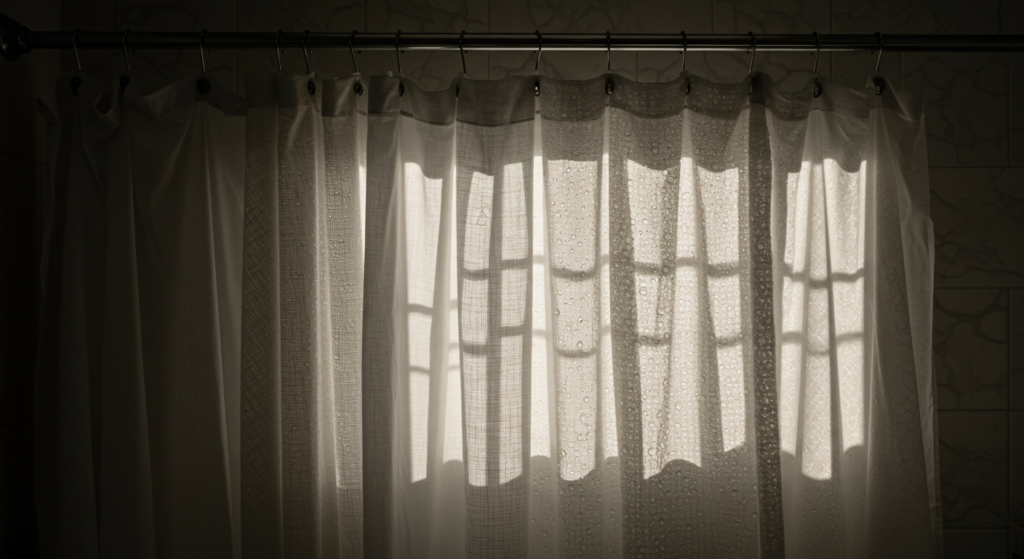
Your curtain material affects both appearance and performance.
Fabric Effects on Light and Space
Material opacity changes your bathroom’s feeling:
- Lightweight, semi-sheer fabrics make small bathrooms feel more open
- Heavier fabrics add coziness and sound absorption to large bathrooms
- Textured materials (waffle weave, cotton duck) add dimension
- Shiny fabrics (polyester blends, sateen) reflect light and brighten dark spaces
Consider how light interacts with your curtain material throughout the day—natural daylight versus evening artificial lighting can dramatically change appearance.
Durability and Maintenance Realities
Be honest about your cleaning habits:
- Polyester and nylon blends offer easy care and fast drying
- 100% cotton provides a high-end look but requires more frequent washing
- Plastic alternatives (PEVA/EVA) can be wiped clean but lack textile richness
- Specialty fabrics (linen blends, textured weaves) often require gentle cycles or spot cleaning
The most beautiful curtain becomes a liability if you won’t maintain it properly. Choose materials that match your realistic cleaning routine.
Seasonal Considerations
Think about year-round performance:
Heavier fabrics create cozy winter bathrooms but can feel stifling in summer. Lighter options feel breezy in warm months but potentially chilly in winter.
Consider whether you’re willing to switch curtains seasonally (like changing bedding) or need one all-season solution.
Shower Curtain Styling Techniques

Beyond basic hanging, these styling approaches elevate your shower curtain game.
Height and Hanging Methods
Proper installation makes a dramatic difference:
- Hang curtains high (2-3 inches from ceiling) to create height
- Allow curtains to “puddle” slightly on the floor for luxury (if using a separate liner)
- Consider ceiling-mounted tracks for modern, hotel-inspired looks
- Try curved shower rods to create more showering space and dramatic curtain presentation
The standard placement (just above tub edge to just below ceiling) works, but intentionally breaking these norms can create designer effects.
Hardware as Design Elements
Don’t overlook curtain hardware:
- Decorative hooks add personality and can be changed seasonally
- Upgraded curtain rods (brushed brass, matte black) elevate basic curtains
- Tie-backs create daytime drapery effects when the shower isn’t in use
- Double-rod systems allow for curtain/liner combinations with clean presentation
Hardware offers affordable personality that can be updated more frequently than the curtain itself.
Layering Strategies
Consider curtain layering for maximum impact:
- Double curtains (pulled from both sides) create symmetrical, formal styling
- Sheer curtains behind patterned ones add depth
- Valances above shower curtains add height and formal structure
- Contrasting liners (visible at the top when curtain is closed) create border effects
These hospitality-inspired techniques bring unexpected sophistication to residential bathrooms.
Special Bathroom Scenarios
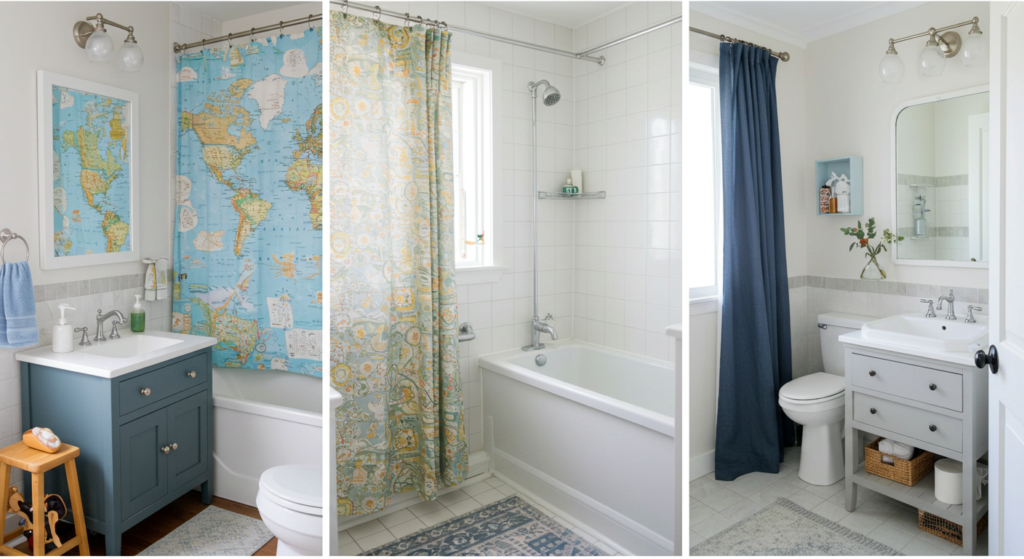
Some bathroom situations require specialized approaches.
Kids’ Bathrooms
Children’s spaces deserve special consideration:
- Washable, durable materials stand up to splashing and frequent cleaning
- Adjustable heights accommodate growing children
- Themed curtains can be educational (maps, animals, letters) as well as decorative
- Clear curtains with pockets can display bath toys or rotating seasonal items
Remember that kids’ tastes change rapidly—choose patterns they can grow with or budget for more frequent updates.
Shared Bathrooms
When multiple people use the same space:
- Gender-neutral patterns prevent anyone feeling the space isn’t “for them”
- Compromise colors (blues + warm accents) satisfy various preferences
- Patterns with multiple colors allow each user to emphasize their favorite through personal accessories
- Durability becomes even more important with increased usage
The goal is creating a space everyone feels ownership of while maintaining design cohesion.
Rental Property Solutions
Working within limitations:
- Tension rods prevent permanent installation needs
- Liner/curtain combinations protect property from moisture damage
- Removable hooks and hardware minimize wall damage
- Neutral bases with changeable accessories allow personalization without major investment
These approaches satisfy landlord requirements while still creating personalized spaces.
Finding Inspiration Sources

Discover where to look for shower curtain styling ideas.
Design Resources and Platforms
The best places to find fresh ideas:
- Pinterest boards dedicated to bathroom styling
- Instagram hashtags (#showercurtainstyle #bathroomdesign)
- Home design magazines (digital and print)
- Hotel bathrooms (luxury hotels often showcase innovative bathroom textiles)
- Bathroom showrooms and high-end department stores
Save images that speak to you, then identify patterns in your selections to understand your personal style preferences.
Trending Patterns for Current Year
Popular patterns that feel fresh right now:
- Botanical prints (monstera leaves, palm fronds, subtle florals)
- Terrazzo-inspired designs (speckled patterns in earthy or bright palettes)
- Watercolor effects (soft, flowing color transitions)
- Bold geometrics (especially hexagons and irregular shapes)
- Global prints (Moroccan tiles, mudcloth-inspired, ikat patterns)
These trends have enough staying power to remain relevant for several years while still feeling current.
Translating Broader Design Trends
Apply whole-home trends to your bathroom:
- Biophilic design (nature-inspired patterns, botanical prints)
- Maximalism (bold pattern mixing, vibrant colors)
- Modern vintage (contemporary takes on retro patterns)
- Japandi (minimalist patterns with natural textures)
- Warm minimalism (textured solids in earthy tones)
Bathroom trends typically follow broader interior design movements but with moisture-friendly adaptations.
Shopping Strategies
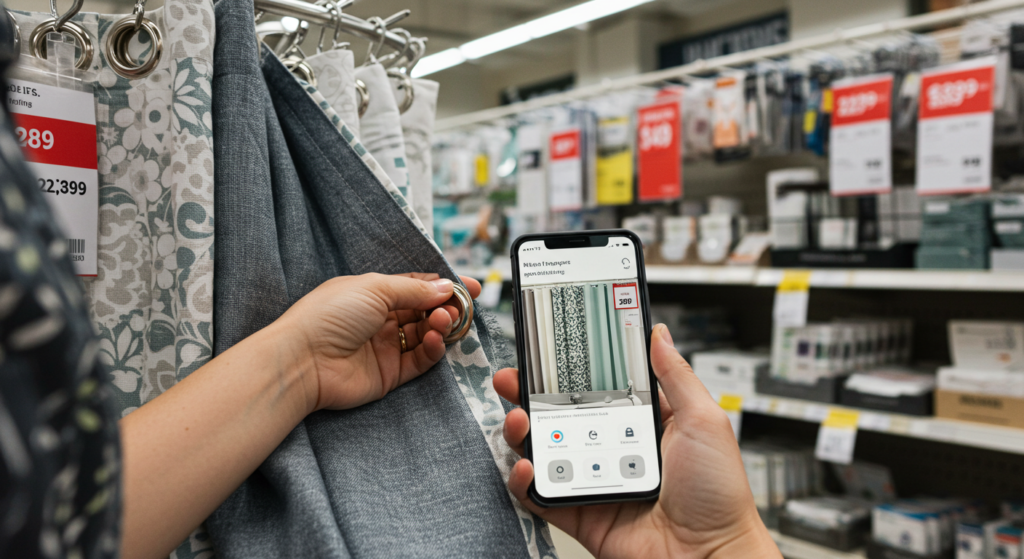
Know where and how to find the perfect shower curtain for your space.
Quality Indicators
Identify superior shower curtains:
- Reinforced top grommets or button holes prevent tearing
- Double-stitched hems maintain shape after washing
- Color-fast fabrics resist fading from cleaning and sunlight
- Weighted hems help curtains hang properly
- Fabric thickness appropriate to purpose (heavier for privacy, lighter for decorative use)
These quality markers distinguish curtains that will last for years versus those needing rapid replacement.
Budget-Friendly Sources
Great curtains exist at every price point:
- Big box stores offer trendy basics at accessible prices
- Online marketplaces provide unique options from independent designers
- Home goods discounters feature brand names at reduced prices
- Seasonal sales (especially January and July) deliver significant savings
- DIY options (fabric + shower curtain hooks) unlock custom possibilities
Set your budget first, then explore options within that range rather than falling in love with unattainable pieces.
Investment-Worthy Upgrades
Where to spend more for significant impact:
- Custom-sized curtains for non-standard showers
- Designer patterns from established textile houses
- Organic and sustainable materials for health-conscious homes
- Extra-long or extra-wide options for luxury showers
- Double-sided printed curtains visible from both inside and outside the shower
These investment areas deliver noticeable quality differences that justify higher price points.
DIY and Customization Options

Personal touches make your bathroom uniquely yours.
Simple Customization Techniques
Easy ways to personalize store-bought curtains:
- Fabric trim additions (pom-pom borders, contrast bands, ribbon details)
- Button or appliqué embellishments
- Fabric paint for custom designs
- Dip-dying solid curtains for ombré effects
- Stenciled patterns or monograms
These approaches transform basic curtains into custom creations with minimal crafting skills required.
Full DIY Project Ideas
For the craft-confident:
- Sew curtains from decorator fabric (with waterproof liner)
- Patchwork curtains from fabric scraps
- Hand-painted designs on blank canvas curtains
- Block-printed patterns using custom stamps
- Quilted shower curtains for textural interest
These projects require more skill but deliver truly one-of-a-kind results impossible to purchase.
Upcycling Possibilities
Sustainable approaches to shower curtain styling:
- Repurpose vintage tablecloths or sheets with added waterproof liners
- Transform outdated curtains with new trim or dye
- Create patchwork from worn-out shower curtains
- Use fabric remnants for color-blocked designs
- Combine parts of multiple curtains for fresh looks
These techniques reduce waste while creating distinctive bathroom features with character and history.
Seasonal Styling Updates

Keep your bathroom fresh through simple changes.
Quick Refresh Strategies
Easy updates without full replacement:
- Swap decorative hooks seasonally (seashells for summer, snowflakes for winter)
- Add temporary ribbon trim for holidays
- Combine with seasonal hand towels in coordinating colors
- Change liner colors for subtle seasonal shifts
- Adjust curtain positioning (fully closed in winter for coziness, partially open in summer for airiness)
These minor changes require minimal investment while keeping your space current.
Holiday and Seasonal Themes
Tasteful ways to acknowledge seasons:
- Subtle color shifts (cool blues/greens for summer, warm rusts/golds for fall)
- Botanical changes (tropical leaves for summer, pine boughs for winter)
- Texture variations (lightweight cotton for summer, heavier textured fabrics for winter)
- Accent changes while maintaining the same base curtain
Avoid overly literal themes (cartoon Santas, Halloween pumpkins) in favor of sophisticated color and texture shifts that suggest seasons.
Storage Solutions
Managing multiple curtain options:
- Roll clean, dry curtains around cardboard tubes
- Store in breathable cotton bags with cedar chips to prevent mustiness
- Label by season or color scheme
- Include maintenance notes (washing instructions, when last cleaned)
- Store decorative hooks with corresponding curtains
Proper storage ensures your curtain collection remains in perfect condition between uses.
Maintenance and Care
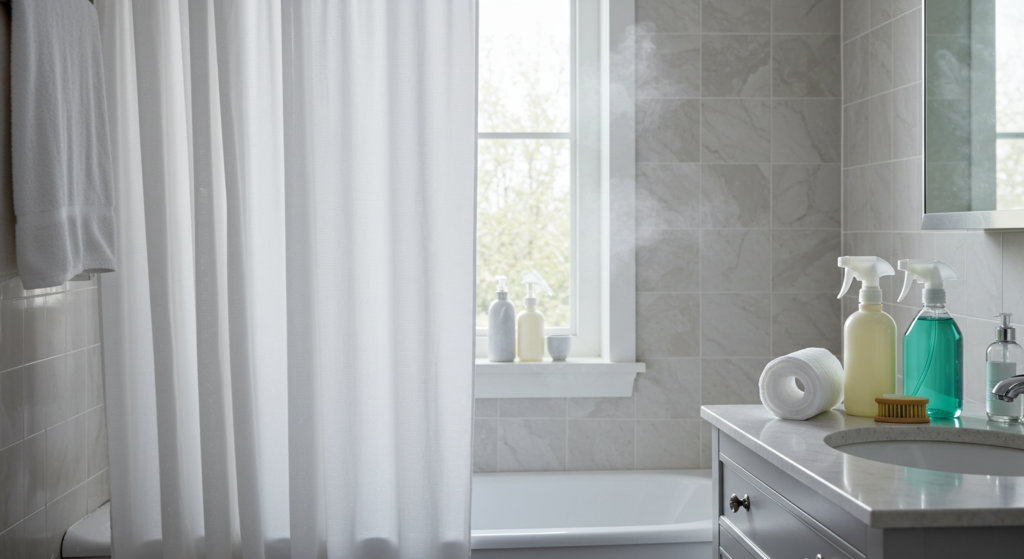
Proper maintenance extends both appearance and lifespan.
Cleaning Best Practices
Keep curtains looking their best:
- Follow manufacturer’s care instructions precisely
- Wash fabric curtains monthly in hot water with vinegar added
- Clean liners biweekly with diluted bleach spray or washing
- Air-dry completely before rehanging to prevent mildew
- Replace liners when cleaning no longer restores appearance
Regular maintenance prevents the buildup of soap scum, mildew, and bacteria that can permanently damage curtains.
Preventing Mold and Mildew
Proactive strategies for humid environments:
- Always use a liner to keep decorative curtains dry
- Close curtains fully after showering (prevents bunching where mold grows)
- Install a bathroom fan and use consistently
- Consider mildew-resistant curtains with antimicrobial treatments
- Spray diluted tea tree oil water for natural mildew prevention
These habits dramatically extend curtain life in moisture-rich bathroom environments.
When to Replace vs. Refresh
Know when to say goodbye:
- Visible mildew that doesn’t respond to cleaning requires replacement
- Fading that detracts from design impact suggests updating
- Torn grommets or hems may be repairable but often signal end-of-life
- Style fatigue sometimes warrants changes even when curtains remain functional
Most quality shower curtains should last 2-5 years with proper care before needing replacement.
Bathroom Accessories Coordination
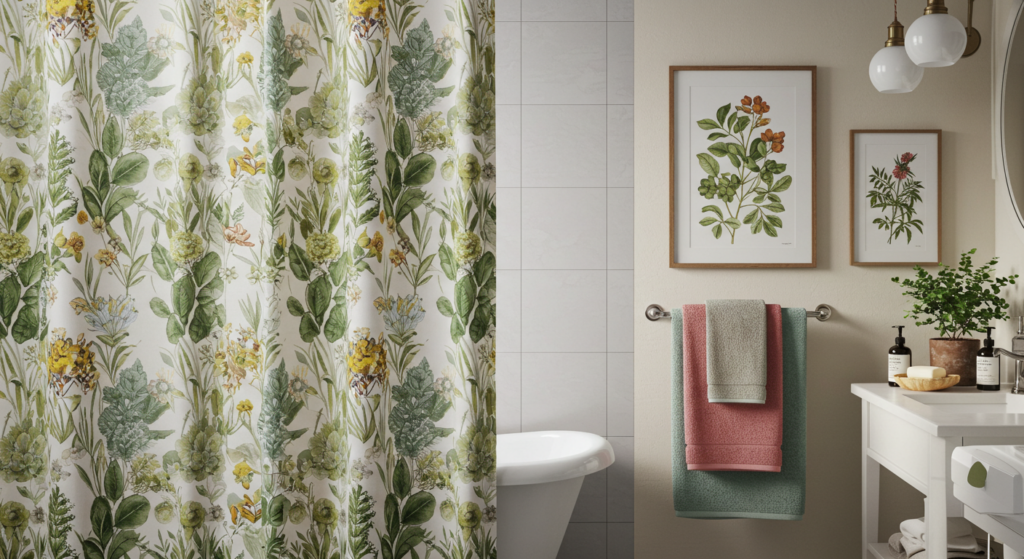
Create a cohesive look beyond just the shower curtain.
Creating Complete Design Stories
Build coordinated bathroom designs:
- Extract 2-3 colors from your shower curtain for accessories
- Repeat pattern elements in small doses (floral curtain → floral soap dish)
- Balance pattern and solid across the space
- Maintain consistent metal finishes throughout
- Consider texture relationships (smooth curtain → textured towels or vice versa)
These relationships create designer-level cohesion that elevates your bathroom’s overall impression.
Small Touches That Make Differences
Details matter in small spaces:
- Coordinated soap dispensers and toothbrush holders
- Towels in complementary (not matching) colors
- Artwork that picks up curtain colors
- Bathmats that acknowledge the curtain’s pattern scale or color
- Even toilet paper can coordinate (colored rolls, decorative holders)
These minor elements create subconscious cohesion that makes spaces feel intentionally designed.
Art and Decor Integration
Finish your bathroom with carefully chosen art:
- Wall art that incorporates shower curtain colors creates connection
- Plants add life and can echo botanical curtain elements
- Decorative storage (baskets, jars) in curtain-complementary colors
- Window treatments that acknowledge curtain patterns
- Mirror frames that repeat metal finishes from shower hardware
These finishing touches complete your bathroom’s design story and elevate basic spaces to designed environments.
Conclusion

Your shower curtain represents one of the simplest yet most impactful ways to transform your bathroom. As the largest textile element in the space, it sets the tone for the entire room and provides endless opportunities for expressing your personal style.
The beauty of shower curtain styling lies in its flexibility—you can create dramatic change without renovation, plumbing work, or major investment.
Simply swapping this single element can refresh your entire bathroom experience, whether you’re working with a rental space, a dated bathroom awaiting renovation, or a pristine new installation needing personality.
Remember that successful shower curtain styling balances practical considerations (material durability, sizing, maintenance) with aesthetic goals (color coordination, pattern selection, overall bathroom harmony).
The most beautiful curtain quickly becomes a frustration if it doesn’t function well in your specific space and lifestyle.
As you select your perfect shower curtain, focus on creating a bathroom that feels both personally expressive and functionally sound—a space that greets you each morning with visual harmony and sends you off to sleep with a sense of order and beauty.
Your shower curtain isn’t just a necessity; it’s an opportunity to make a design statement that elevates your daily routine.
Summary Table: Quick Selection Guide
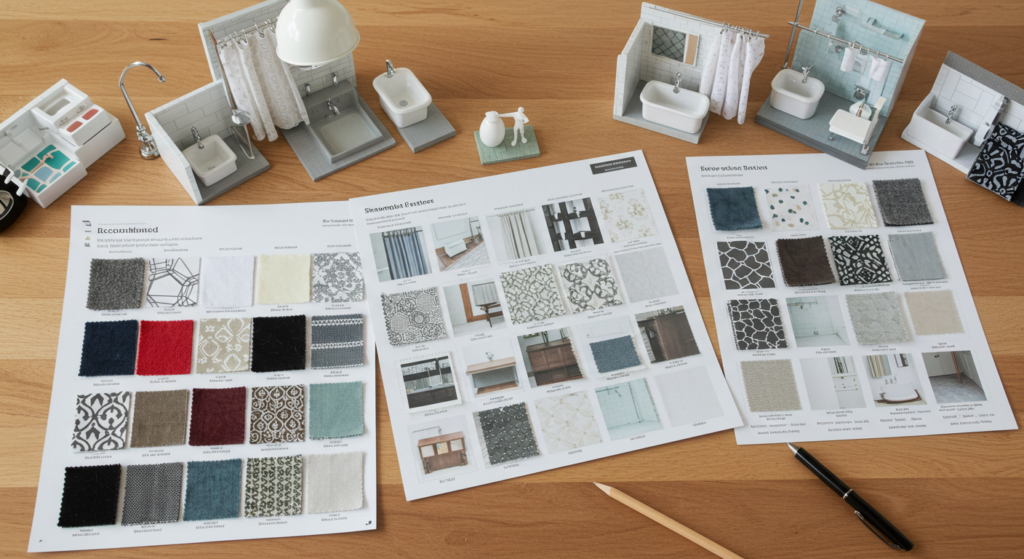
| Bathroom Type | Recommended Patterns | Ideal Colors | Best Materials | Special Considerations |
|---|---|---|---|---|
| Small Bathroom | Small-scale patterns, vertical stripes | Light, cool tones | Lightweight polyester, semi-transparent | High hanging, light-reflecting |
| Large Bathroom | Large-scale patterns, bold prints | Any, including dark tones | Heavier fabrics, textured materials | Double curtains, dramatic presentation |
| Kids’ Bathroom | Durable patterns, educational themes | Bright, washable colors | PEVA, polyester | Extra durability, adjustable height |
| Guest Bathroom | Universally appealing patterns | Neutral with subtle accents | Easy-care fabrics | Low maintenance, classic appeal |
| Master Bathroom | Sophisticated patterns, luxury textures | Coordinated with bedroom | Premium materials | Statement styling, seasonal updates |
| Rental Bathroom | Removable options, neutral bases | Versatile color schemes | Standard sizes, tension-rod compatible | Non-damaging installation, portable |
Frequently Asked Questions
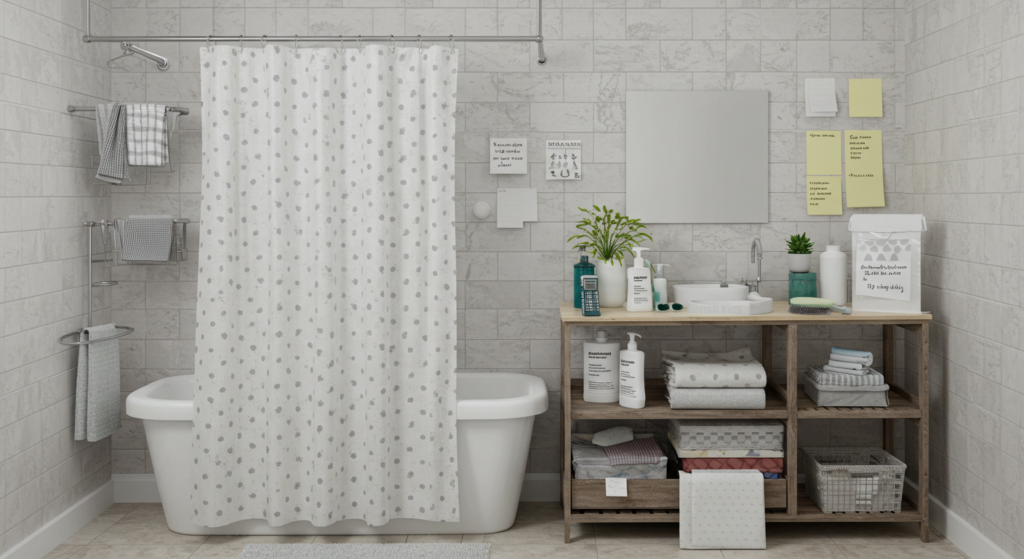
How often should I replace my shower curtain?
Decorative fabric curtains typically last 2-5 years with proper care. Liners should be replaced every 6-12 months or whenever cleaning no longer restores their appearance. If you notice persistent mildew smell despite cleaning, it’s definitely time for a replacement.
Can I use a regular curtain as a shower curtain?
Yes, with caution. Regular curtains can be used as decorative shower curtains if paired with a waterproof liner. Choose machine-washable fabrics and be prepared for more frequent cleaning. Avoid silks, rayons, or other fabrics that don’t handle moisture well.
What’s the best way to prevent mildew on shower curtains?
The three-part approach works best: 1) Always use a liner to keep decorative curtains dry, 2) Extend curtains fully after showering to prevent moist bunching, and 3) Maintain good bathroom ventilation. Regular washing with vinegar added to detergent helps eliminate existing mildew.
How do I choose a shower curtain for a very small bathroom?
For tiny spaces, select light colors, small-scale patterns, or solid curtains with subtle texture. Hang the curtain higher than standard to create vertical space. Consider semi-transparent options that don’t visually block the room. A curved shower rod can add showering space without requiring more square footage.
What’s the difference between a shower curtain and a liner?
A shower curtain is the decorative outer layer visible from the bathroom, while a liner is the waterproof inner layer that prevents water from escaping the shower. Liners are typically made from plastic materials (vinyl, PEVA, EVA), while curtains can be fabric, plastic, or blended materials. Some shower curtains are designed to function as both (especially polyester ones).
How do I coordinate my shower curtain with existing tile I can’t change?
Extract a secondary or accent color from your tile to use in your curtain—not the primary tile color, which would be overwhelming. If working with dated or challenging tile, choose curtains with multiple colors that include your tile color but don’t emphasize it. Neutral curtains with subtle pattern often work well with bold vintage tile.
Are there eco-friendly shower curtain options?
Yes! Look for curtains made from organic cotton, hemp, or recycled polyester. Choose PEVA or EVA liners instead of PVC vinyl, as they don’t contain chlorine. Some companies now offer biodegradable or recyclable options as well. Hemp curtains provide natural mildew resistance with less environmental impact.
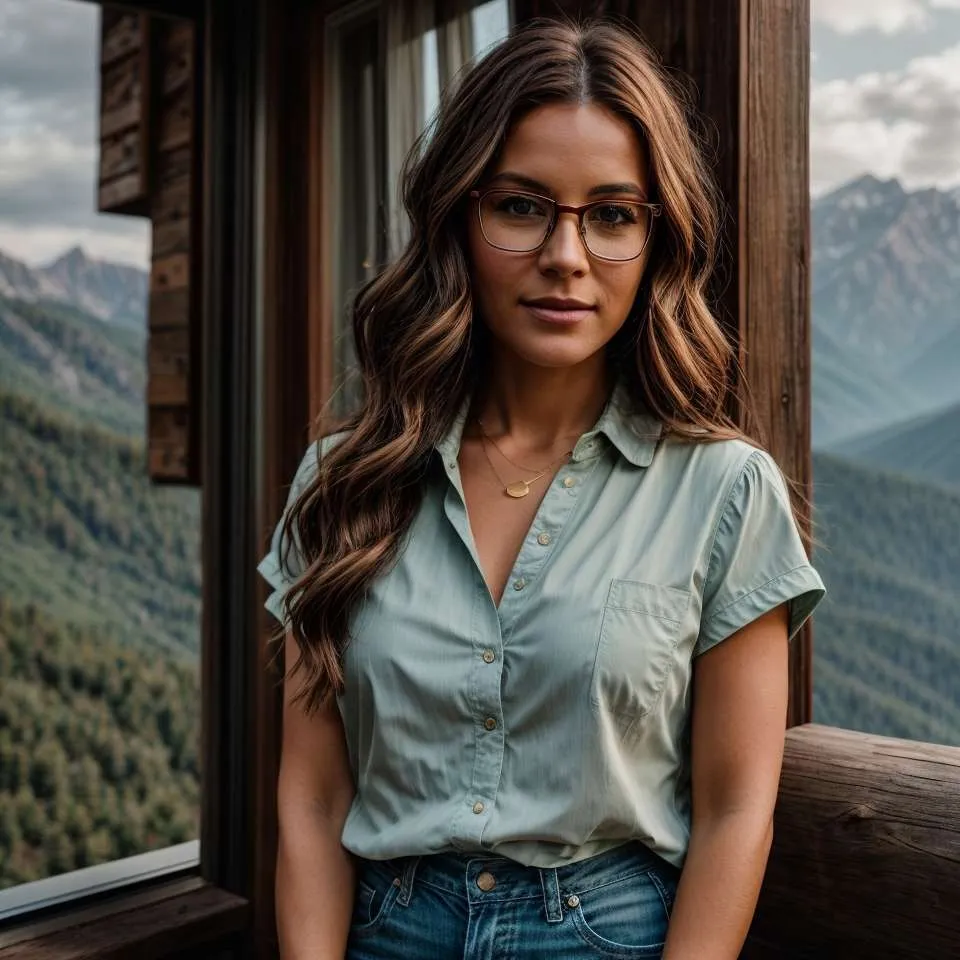
Marcella Raskin is a talented writer and editor with a deep passion for the dynamic realm of clothing colors and patterns. Armed with a strong background in Journalism, she crafts engaging content that empowers readers to select the perfect shades for their outfits. Her pieces provide an in-depth exploration of color trends and expertly curated fashion advice. Beyond her work, Marcella loves discovering new places, connecting with local designers, and advocating for sustainable fashion choices. She is devoted to helping individuals make enlightened color choices for their attire.
Reviewed By: Joanna Perez and Anna West
Edited By: Lenny Terra
Fact Checked By: Matthew Mansour
Photos Taken or Curated By: Matthew Mansour
